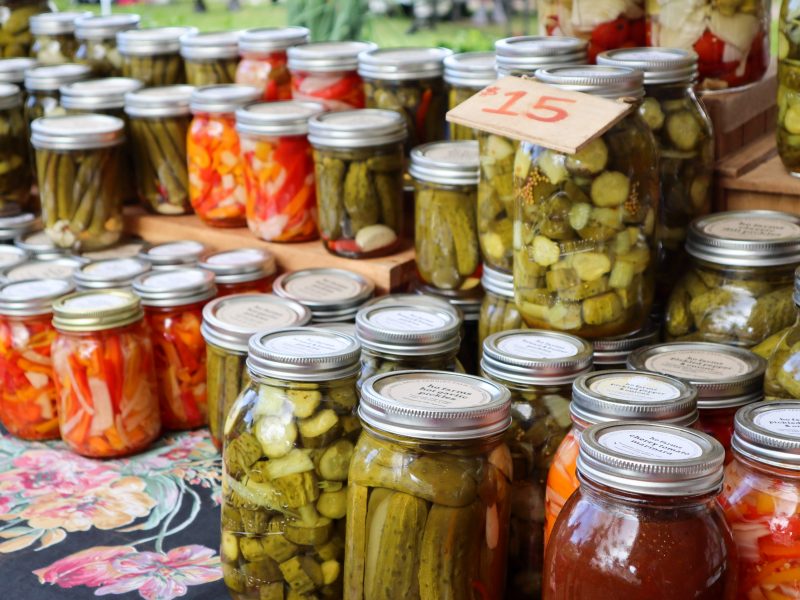Gut health plays a crucial role in overall well-being, influencing digestion, immunity, mood, and even skin health. A well-balanced gut microbiome, the community of beneficial bacteria in the digestive tract, helps maintain a strong gut lining, supports nutrient absorption, and regulates inflammation. However, for individuals with histamine intolerance, maintaining gut health can be tricky. Many traditional gut-boosting foods are high in histamine and can trigger uncomfortable symptoms.
How can you feed your good gut bacteria without triggering a histamine reaction?
This month’s blog looks at how to choose gut-friendly, histamine-conscious foods to support digestion, your gut health, without causing flare-ups.
Understanding Gut Bacteria and Histamine Intolerance
The gut microbiome consists of trillions of bacteria, both beneficial and potentially harmful. A well-balanced microbiome helps break down food, synthesize essential nutrients, and maintain a healthy immune system. However, certain bacteria can contribute to histamine production, worsening symptoms for those with histamine intolerance.
Histamine intolerance occurs when the body has difficulty breaking down histamine due to a deficiency in diamine oxidase (DAO), the enzyme responsible for histamine metabolism. When histamine accumulates, symptoms such as headaches, skin rashes, bloating, fatigue, and digestive distress can occur. Read more about histamine intolerance here.
In the gut, some bacteria produce histamine, while others help break it down. The goal for histamine intolerant individuals is to nurture bacteria that support gut health without triggering histamine overload.
Things like Leaky gut and SIBO (Small Intestinal Bacterial Overgrowth) can worsen histamine intolerance too. This occurs by increasing gut permeability and allowing histamine-producing bacteria to thrive, leading to higher histamine levels and intensified symptoms. Read more about leaky gut here.
Or read about if SIBO is making your histamine intolerance worse here.
Feed Your Gut Bacteria Without Triggering A Histamine Reaction:
1. Choose Prebiotic-Rich, Low-Histamine Foods
Prebiotics are fibres and resistant starches that serve as food for beneficial gut bacteria. Unlike probiotics, which introduce new bacteria, prebiotics help existing good bacteria thrive. Good news is, several prebiotic-rich foods are low in histamine, making them safe for those with histamine intolerance:
- Root vegetables (sweet potatoes, carrots, parsnips, turnips)
- Green Bananas (although this can be in the test me category of the fruits in the Low Histamine food guide)
- Apples and pears (peeled, if necessary, to reduce fibre load)
- Asparagus
- Zucchini
- Brussels sprouts (tolerated in small amounts by some)
- Coconut flour and tigernut flour (excellent for baking while feeding beneficial bacteria)
2. Support a Balanced Gut with Low-Histamine Probiotic Foods
Traditional fermented foods like sauerkraut, kimchi, and yoghurt are typically high in histamine, making them unsuitable for histamine-sensitive individuals. Instead, focus on foods that encourage natural probiotic diversity without fermentation:
- Freshly cooked, unfermented vegetables
- Fresh herbs like basil, thyme, and oregano (these have mild antimicrobial effects and help regulate gut bacteria)
3. Consume Resistant Starches to Feed Beneficial Bacteria
Resistant starches are a unique type of fibre that escapes digestion in the small intestine and ferments in the large intestine, feeding short-chain fatty acid-producing bacteria. These fatty acids support gut lining health and reduce inflammation, benefiting histamine-sensitive individuals.
Safe resistant starch sources include:
- Cooked and cooled white rice
- Cooked and cooled sweet potatoes
- Green bananas and plantains
- Tigernuts
4. Avoid High-Histamine, Gut-Disrupting Foods
Certain foods can increase histamine levels and disrupt the gut microbiome. If you have histamine intolerance, limit or avoid:
- Fermented foods (sauerkraut, kimchi, kombucha, miso, soy sauce) – these are great for the gut so if you can tolerate some they are good to try.
- Aged and cured meats (salami, prosciutto, aged beef)
- Dried fruits (raisins, dates, figs)
- Leftover foods (as histamine accumulates in leftovers)
- Alcohol (wine, beer, and fermented liquors are high in histamine)
- Tomatoes, eggplant, and spinach (naturally high in histamine and may trigger symptoms)
Many of these are in the Top 10 High Histamine foods. As a refresh, here is the Top 10 High Histamine Foods.
5. Incorporate Anti-Inflammatory, Gut-Healing Foods
A histamine-friendly gut-healing diet should focus on reducing inflammation and strengthening the gut lining.
Gut-friendly, low-histamine foods include:
- Wild-caught fish (fresh, not canned or aged) for omega-3s
- Freshly cooked poultry
- Chia seeds (great for fibre)
- Bone broth (if tolerated) Or here is my Low Histamine Chicken Broth recipe.
- Fresh herbs like rosemary, cilantro, and basil (which have antimicrobial properties)
- Or herbs like turmeric and ginger (which are anti-inflammatory)
6. Practice Mindful Eating and Stress Reduction
Gut health is influenced by more than just diet. Stress and lifestyle habits play a major role in digestion and gut bacteria balance. Stress triggers the release of cortisol, which can alter gut bacteria and increase inflammation.
To support digestion and histamine balance:
- Chew food thoroughly to aid digestion
- Eat in a relaxed state (avoid eating when stressed or rushed)
- Incorporate deep breathing and mindfulness techniques. More about this approach in my BrainFood Program.
- Get quality sleep to regulate histamine and gut bacteria
- Exercise moderately to stimulate healthy gut function. Read more about Exercise and Histamine Intolerance here.
Maintaining a healthy gut microbiome while managing histamine intolerance requires understanding gut health as well as low and high histamine foods and their impact on the body. By choosing prebiotic-rich, low-histamine foods, avoiding gut-disrupting triggers, and incorporating gut-healing habits, you can feed your good gut bacteria without triggering a Histamine reaction.
Each person’s tolerance is unique, so listen to your body, introduce new foods gradually, and track symptoms. With the right strategies, you can support a thriving gut microbiome while keeping histamine intolerance under control.
Struggling to get answers about your histamine intolerance symptoms?
Watch my free Masterclass – The 5 Steps to Healing from Histamine Intolerance.
You will learn my 5-Step plan, the exact same method I used to recover from histamine intolerance. These 5 steps everyone with histamine intolerance must know to resolve all those confusing symptoms and get back to eating foods you love without fear!


 The 3 types of SIBO
The 3 types of SIBO